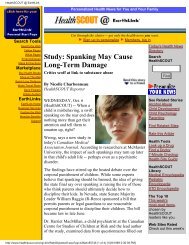The New York Times Magazine, Sunday, August 22, 1999
The New York Times Magazine, Sunday, August 22, 1999
The New York Times Magazine, Sunday, August 22, 1999
Create successful ePaper yourself
Turn your PDF publications into a flip-book with our unique Google optimized e-Paper software.
States Criticized on Lax Lead Tests for Poor Youths<br />
auditors found that fewer than 1 percent of the children on Medicaid had been<br />
tested for lead poisoning. Elsewhere, they said, rates range from 3 percent in<br />
Montana to 10 percent in Colorado, 40 percent in <strong>New</strong> Jersey and 46 percent in<br />
Alabama. Many states, including Connecticut, said they did not have statewide<br />
data on testing rates or the prevalence of lead poisoning.<br />
<strong>New</strong> <strong>York</strong> has a state law that requires day-care centers and nursery schools to<br />
ask parents for evidence of screening. <strong>The</strong> <strong>New</strong> <strong>York</strong> City Health Department<br />
reported that more than 40 percent of children ages 1 to 5 had been tested.<br />
Statewide data for <strong>New</strong> <strong>York</strong> were not immediately available.<br />
Despite the Federal requirements, Thomas W. Bedell, the Medicaid director in<br />
Washington state, said: "We don't believe we have much of a problem with lead<br />
exposure here. So we don't think it's cost-effective to impose 100 percent<br />
screening. <strong>The</strong>re are better ways to spend our money."<br />
Dr. Maxine D. Hayes, the acting health officer for Washington state, added, "We<br />
don't think it's right for the Federal Government to dictate what states should do"<br />
in testing children.<br />
Under Federal rules, Medicaid will pay for testing and treating a child, but will<br />
not pay for testing of substances like water and paint that are sent to a laboratory<br />
for analysis.<br />
"Medicaid reimbursement is available only for the provision of medical<br />
services," said Sally K. Richardson, director of the Federal Medicaid program.<br />
"Water and paint are environmental elements. If a child has already been<br />
diagnosed as lead-poisoned, the testing of these elements serves no direct<br />
medical purpose."<br />
But public health experts say this policy often cripples efforts to identify the<br />
cause of a child's lead poisoning.<br />
<strong>The</strong> advisory panel that voiced concern about the low rates of screening also said<br />
this week that Medicaid should pay for laboratory tests of dust, water and other<br />
substances in the homes of children poisoned by lead.<br />
"Such testing is good public health policy, and it's definitely the standard of care<br />
for treating lead-poisoned kids," said Dr. Cummins, the chairwoman of the<br />
panel, the Advisory Committee on Childhood Lead Poisoning Prevention.<br />
Heather M. Mauro, a resident of Atco, N.J., said she felt fortunate that her<br />
children had been tested for lead because the tests detected high levels of lead in<br />
all four youngsters.<br />
<strong>The</strong>ir home, a large Victorian, was built in the late 1800's or early 1900's.<br />
http://www.nytimes.com/library/national/08<strong>22</strong>99lead-poison.html (3 of 4) [8/<strong>22</strong>/<strong>1999</strong> 10:<strong>22</strong>:43 PM]






